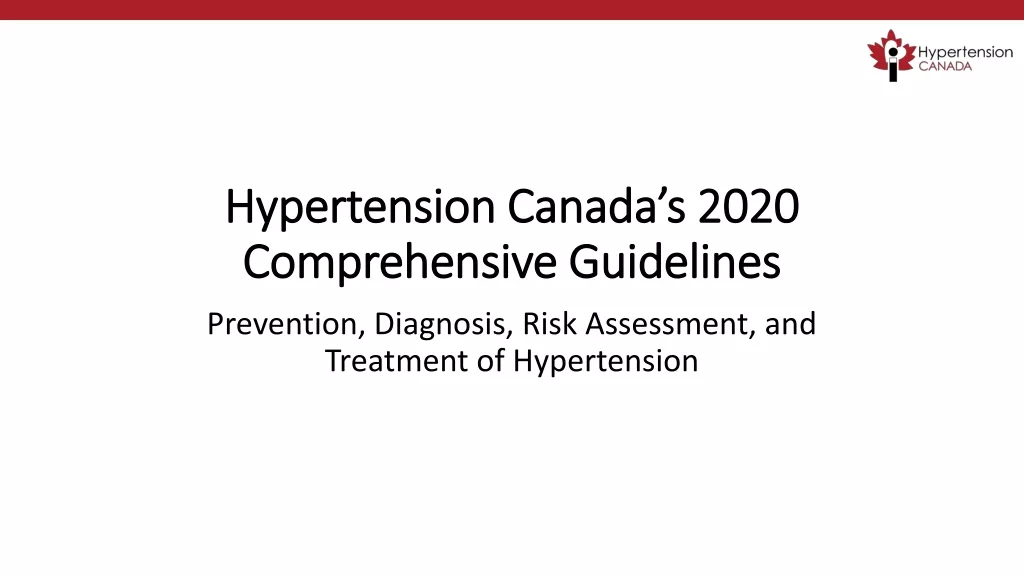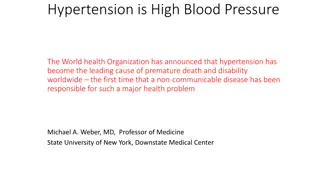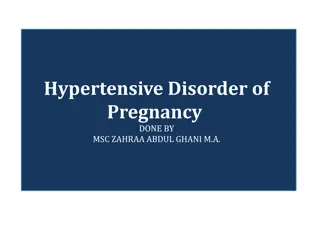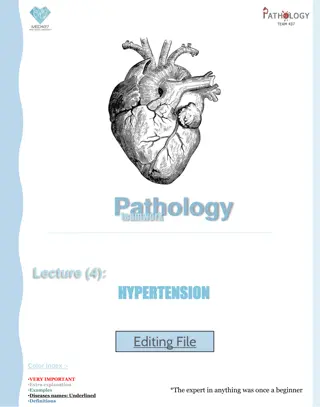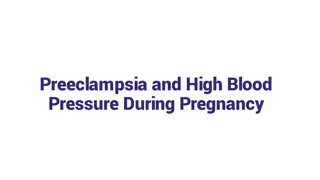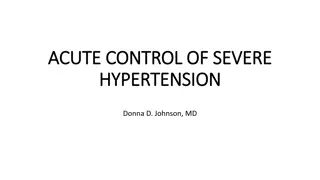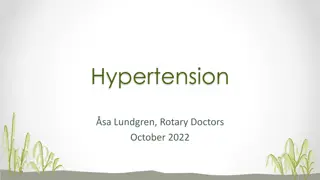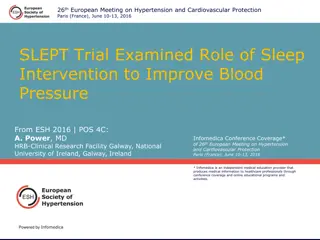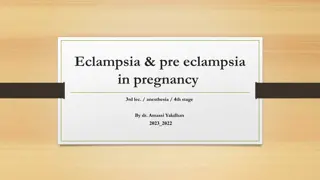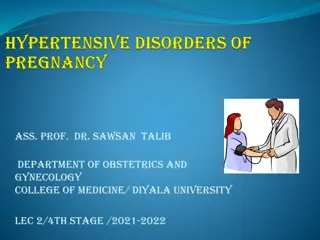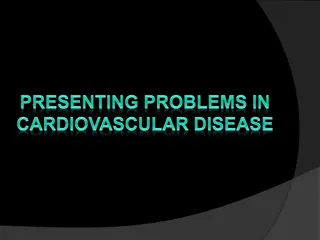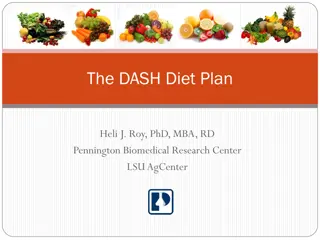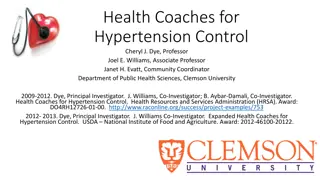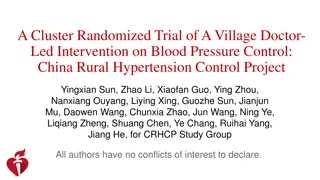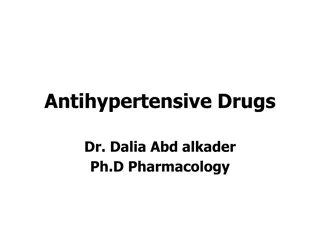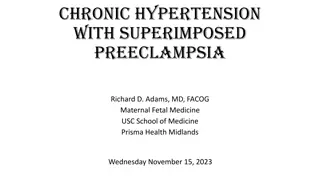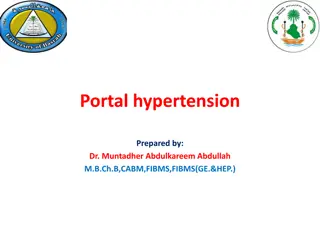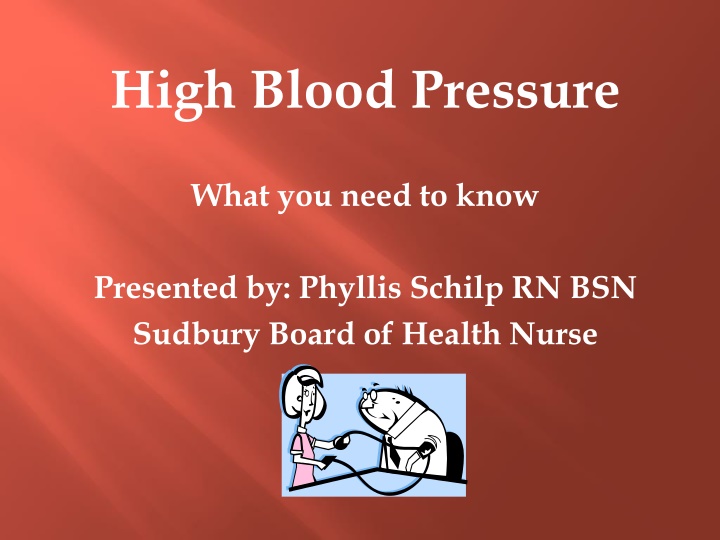
High Blood Pressure: What You Need to Know
Learn about high blood pressure, its measurement guidelines, categories, risks, and management. Discover how hypertension can lead to serious health issues like heart disease, stroke, and kidney disease. Find out the importance of monitoring blood pressure levels regularly and factors that can increase the risk of developing high blood pressure.
Download Presentation

Please find below an Image/Link to download the presentation.
The content on the website is provided AS IS for your information and personal use only. It may not be sold, licensed, or shared on other websites without obtaining consent from the author. If you encounter any issues during the download, it is possible that the publisher has removed the file from their server.
You are allowed to download the files provided on this website for personal or commercial use, subject to the condition that they are used lawfully. All files are the property of their respective owners.
The content on the website is provided AS IS for your information and personal use only. It may not be sold, licensed, or shared on other websites without obtaining consent from the author.
E N D
Presentation Transcript
High Blood Pressure What you need to know Presented by: Phyllis Schilp RN BSN Sudbury Board of Health Nurse
Blood Pressure is the force of the blood pushing against the walls of arteries. Blood Pressure is written as two numbers. Systolic/Diastolic numbers. New Guidelines from JNC gives new BP measurement guidelines.
SYSTOLIC DIASTOLIC The top or first number of your blood pressure reading. Systolic pressure is the higher number & measures your heart while it beats (at work). In Older People the most common form of high blood pressure is systolic pressure elevation. The bottom or second number of your blood pressure reading. Diastolic pressure is the lower number & measures your pressure when it relaxes between beats (at rest).
CATAGORY SYSTOLIC DIASTOLIC NORMAL PRE- HYPERTENSIVE HIGH BLOOD PRESSURE STAGE 1 HIGH BLOOD PRESSURE STAGE 2 HYPERTENSIVE CRISIS (EMERGENCY) LESS THAN 120 120-139 OR LESS THAN 80 80-89 140-159 OR 90-99 160 OR HIGHER OR 100 OR HIGHER HIGHER THAN 180 OR HIGHER THAN 110
Hypertension, or high blood pressure, is a common condition that will catch up with most people who live into older age. Hypertension raises the heart's workload and can cause serious damage to the arteries. Over time, uncontrolled high blood pressure increases the risk of heart disease, stroke, and kidney disease.
High Blood Pressure is a pressure of 120/80 It can t be cured but can be managed Usually no signs or symptoms 76.4 Million Americans over age 20 have it Life long disease
Up to the age of 45, more men have high blood pressure than women. It becomes more common for both men and women as they age, and more women have hypertension by the time they reach 65. You have a greater risk if a close family member has high blood pressure or if you are diabetic. About 60% of people with diabetes have high blood pressure.
Stroke Heart Attack Angina Kidney Failure Peripheral Artery Disease Blindness
Age- Increases as you get older Gender- Men have a higher incidence Family History- Runs in some families Smoking Obesity Excessive Alcohol consumption Lack of physical exercises Diabetes
Sodium, a major component of salt, can raise blood pressure by causing the body to retain fluid, which leads to a greater burden on the heart. The American Heart Association recommends eating less than 1,500 milligrams of sodium per day. You'll need to check food labels and menus carefully. Processed foods contribute up to 75% of our sodium intake. Canned soups and lunch meats are prime suspects.
Being overweight places a strain on your heart and increases your risk of high blood pressure. That is why diets to lower blood pressure are often also designed to control calories. They typically call for cutting fatty foods and added sugars, while increasing fruits, vegetables, lean protein, and fiber. Even losing 10 pounds can make a difference.
Drinking too much alcohol can increase your blood pressure. Guidelines from the American Heart Association state that if you drink alcohol, you should limit the amount to no more than two drinks a day for men, or one a day for women. They define a drink as one 12- ounce beer, four ounces of wine, 1.5 ounces of 80-proof spirits, or one ounce of 100-proof spirits.
Cold and flu medicines that contain decongestants are one of several classes of medicine that can cause your blood pressure to rise. Others include NSAID pain relievers, steroids, diet pills, birth control pills, and some antidepressants. If you have high blood pressure, talk to you doctor about what medicines and supplements you are taking that may affect blood pressure.
You may be able to lower your blood pressure by switching to a better diet. The DASH Diet -- Dietary Approaches to Stop Hypertension -- involves eating more fruits, vegetables, whole- grain foods, low-fat dairy, fish, poultry, and nuts. You should eat less red meat, saturated fats, and sweets. Reducing sodium in your diet can also have a significant effect.
Regular exercise helps lower your blood pressure. Adults should get about 150 minutes of moderate-intensity exercise every week. That could include gardening, walking briskly, bicycling, or other aerobic exercise. Muscle- strengthening activities are recommended at least two days a week and should work all major muscle groups.
Hypertension is often a life-long condition. It's important to take your medications and continue to monitor your blood pressure. If you keep it under control, you can reduce your risk of stroke, heart disease, and kidney failure.
Modification Recommendation Approximate SBP Reduction Range 5-20 mmHg 10 kg loss 8-14 mmHg Weight reduction Maintain normal body weight Diet rich in fruits, veggies, low fat diary and reduced in fat < 2.4 grams of sodium per day 30 minutes of aerobic exercise 2 drinks/day for men 1 drink/day for women DASH eating plan Restrict Sodium Intake Physical Activity 2-8 mmHg 4-10 mmHg Moderate alcohol 2-4 mmHg
Achieve a calm state Make sure you are quiet and relaxed Sit calmly without talking for 5 minutes Avoid caffeine, alcohol, and smoking Body posture is important Sit in a chair with feet flat on floor Legs should not be crossed Arms should be bare and at heart level 1. 2. 3. 1. 2. 3.
Calibrate & check equipment Use a properly calibrated and validated instrument Check the cuff size and fit Double check any high readings If BP registers high, take two readings 5 minutes apart Confirm any elevated readings in opposite arm 1. 2. 1. 2.
American Heart Association, 2012, Hypertension, http://www.heart.org/HEARTORG/Conditions/H ighBloodPressure/High-Blood-Pressure-or- Hypertension_UCM_002020_SubHomePage.jsp National Heart Lung and Blood Institute, 2012, Hypertension, http://www.nhlbi.nih.gov/health/public/heart/in dex.htm#hbp WebMD, 2012, Hypertension, http://www.webmd.com/hypertension-high- blood-pressure/ss/slideshow-hypertension- overview

